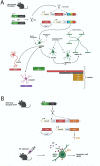Novel Tools and Investigative Approaches for the Study of Oligodendrocyte Precursor Cells (NG2-Glia) in CNS Development and Disease
- PMID: 33994951
- PMCID: PMC8116629
- DOI: 10.3389/fncel.2021.673132
Novel Tools and Investigative Approaches for the Study of Oligodendrocyte Precursor Cells (NG2-Glia) in CNS Development and Disease
Abstract
Oligodendrocyte progenitor cells (OPCs), also referred to as NG2-glia, are the most proliferative cell type in the adult central nervous system. While the primary role of OPCs is to serve as progenitors for oligodendrocytes, in recent years, it has become increasingly clear that OPCs fulfil a number of other functions. Indeed, independent of their role as stem cells, it is evident that OPCs can regulate the metabolic environment, directly interact with and modulate neuronal function, maintain the blood brain barrier (BBB) and regulate inflammation. In this review article, we discuss the state-of-the-art tools and investigative approaches being used to characterize the biology and function of OPCs. From functional genetic investigation to single cell sequencing and from lineage tracing to functional imaging, we discuss the important discoveries uncovered by these techniques, such as functional and spatial OPC heterogeneity, novel OPC marker genes, the interaction of OPCs with other cells types, and how OPCs integrate and respond to signals from neighboring cells. Finally, we review the use of in vitro assay to assess OPC functions. These methodologies promise to lead to ever greater understanding of this enigmatic cell type, which in turn will shed light on the pathogenesis and potential treatment strategies for a number of diseases, such as multiple sclerosis (MS) and gliomas.
Keywords: NG2-glia; genetic alteration; heterogeneity; imaging; oligodendrocyte precursor cells; sequencing.
Copyright © 2021 Galichet, Clayton and Lovell-Badge.
Conflict of interest statement
The authors declare that the research was conducted in the absence of any commercial or financial relationships that could be construed as a potential conflict of interest.
Figures


Similar articles
-
Oligodendrocyte progenitor cells in Alzheimer's disease: from physiology to pathology.Transl Neurodegener. 2023 Nov 14;12(1):52. doi: 10.1186/s40035-023-00385-7. Transl Neurodegener. 2023. PMID: 37964328 Free PMC article. Review.
-
Evidence that perinatal and adult NG2-glia are not conventional oligodendrocyte progenitors and do not depend on axons for their survival.Mol Cell Neurosci. 2003 Aug;23(4):544-58. doi: 10.1016/s1044-7431(03)00176-3. Mol Cell Neurosci. 2003. PMID: 12932436
-
Sequential specification of oligodendrocyte lineage cells by distinct levels of Hedgehog and Notch signaling.Dev Biol. 2018 Dec 15;444(2):93-106. doi: 10.1016/j.ydbio.2018.10.004. Epub 2018 Oct 19. Dev Biol. 2018. PMID: 30347186 Free PMC article.
-
Ecotropic Murine Leukemia Virus Infection of Glial Progenitors Interferes with Oligodendrocyte Differentiation: Implications for Neurovirulence.J Virol. 2016 Jan 13;90(7):3385-99. doi: 10.1128/JVI.03156-15. J Virol. 2016. PMID: 26764005 Free PMC article.
-
Keeping the ageing brain wired: a role for purine signalling in regulating cellular metabolism in oligodendrocyte progenitors.Pflugers Arch. 2021 May;473(5):775-783. doi: 10.1007/s00424-021-02544-z. Epub 2021 Mar 13. Pflugers Arch. 2021. PMID: 33712969 Free PMC article. Review.
Cited by
-
H3K27M mutant glioma: Disease definition and biological underpinnings.Neuro Oncol. 2024 May 3;26(Supplement_2):S92-S100. doi: 10.1093/neuonc/noad164. Neuro Oncol. 2024. PMID: 37818718 Free PMC article. Review.
-
Hypopituitarism in Sox3 null mutants correlates with altered NG2-glia in the median eminence and is influenced by aspirin and gut microbiota.PLoS Genet. 2024 Sep 26;20(9):e1011395. doi: 10.1371/journal.pgen.1011395. eCollection 2024 Sep. PLoS Genet. 2024. PMID: 39325695 Free PMC article.
-
The Properties and Functions of Glial Cell Types of the Hypothalamic Median Eminence.Front Endocrinol (Lausanne). 2022 Jul 27;13:953995. doi: 10.3389/fendo.2022.953995. eCollection 2022. Front Endocrinol (Lausanne). 2022. PMID: 35966104 Free PMC article. Review.
-
Oligodendrocyte progenitor cells in Alzheimer's disease: from physiology to pathology.Transl Neurodegener. 2023 Nov 14;12(1):52. doi: 10.1186/s40035-023-00385-7. Transl Neurodegener. 2023. PMID: 37964328 Free PMC article. Review.
-
The role of hypothalamic endoplasmic reticulum stress in schizophrenia and antipsychotic-induced weight gain: A narrative review.Front Neurosci. 2022 Sep 16;16:947295. doi: 10.3389/fnins.2022.947295. eCollection 2022. Front Neurosci. 2022. PMID: 36188456 Free PMC article. Review.
References
Grants and funding
LinkOut - more resources
Full Text Sources
Other Literature Sources

